This page covers the following models :
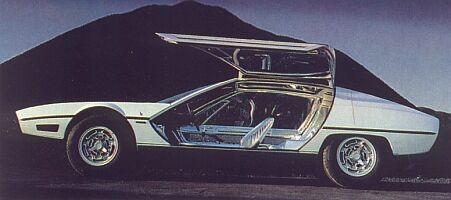 The
Marzal was first shown to the public at the Geneva Motorshow in 1967. A
concept car designed by Gandini (who was working at Bertone), it was Lamborghinis first
attempt at a proper four-seater. It used a stretched Miura
chassis with an in-line six-cylinder 2-litre engine mounted transversely
at the rear. This was derived from the V12 unit in the Miura, effectively
being the latter engine cut in half longitudinally. The external design was dominated by the almost completely
glass gull-wing doors and the transparent roof panel, and the noticeable lack of height, the overall height was only 1100mm.
Lamborghini did not like the design and so it remained a one-off. The next attempt at a four-seater
was the Espada.
The
Marzal was first shown to the public at the Geneva Motorshow in 1967. A
concept car designed by Gandini (who was working at Bertone), it was Lamborghinis first
attempt at a proper four-seater. It used a stretched Miura
chassis with an in-line six-cylinder 2-litre engine mounted transversely
at the rear. This was derived from the V12 unit in the Miura, effectively
being the latter engine cut in half longitudinally. The external design was dominated by the almost completely
glass gull-wing doors and the transparent roof panel, and the noticeable lack of height, the overall height was only 1100mm.
Lamborghini did not like the design and so it remained a one-off. The next attempt at a four-seater
was the Espada.
Technical Details
| Engine | 1964cc (82x62mm) 6 cylinder with 175bhp @ 6,800rpm |
| Suspension | front : McPherson struts with coil spring/damper units and lower transverse arms plus anti-roll bar
rear : McPherson struts with coil spring/damper units and lower transverse arms plus anti-roll bar wheelbase : 2620mm track (front/rear) : 1480mm/1480mm |
| Brakes | discs all round with servo assistance
mechanical handbrake operating on the rear wheels |
| Transmission | 5 speed manual |
| Steering | rack-and-pinion (ZF) |
| Kerb weight | 1,200kg |
A true grand tourer rather than a sports car, the Espada was nevertheless complimented for its neutral handling and exceptional roadholding (in the
dry at least). Very little wind noise enabled comfortable high speed cruising, but the common Lamborghini criticisms of heavy steering, poor driving
position and chaotic cockpit design remained, at least on the early cars. The big 4-litre V12 engine at the front was more suited to higher engine speeds, where throttle response and
power were exceptional, rather than the lower regimes.
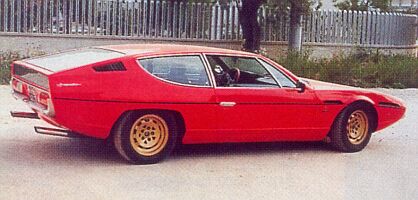 The
next four seater design from Lamborghini reverted back to the conventional
front-engine, rear-wheel-drive layout used in the Islero.
That latter car donated almost all the drivetrain and suspension,
whilst the chassis was a heavily modified Miura unit. The design was taken
mainly from another Bertone showcar of 1967, the Pirana (which had been based on Jaguar
mechanicals). A true four-seater, the resulting Espada was unveiled at
the Geneva Motorshow in 1968, then being the fastest four-seater production car in the world, with a claimed top speed of 155mph.
The
next four seater design from Lamborghini reverted back to the conventional
front-engine, rear-wheel-drive layout used in the Islero.
That latter car donated almost all the drivetrain and suspension,
whilst the chassis was a heavily modified Miura unit. The design was taken
mainly from another Bertone showcar of 1967, the Pirana (which had been based on Jaguar
mechanicals). A true four-seater, the resulting Espada was unveiled at
the Geneva Motorshow in 1968, then being the fastest four-seater production car in the world, with a claimed top speed of 155mph.
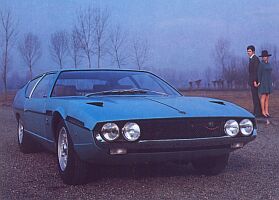 The second series, built from 1969, used the more powerful engine from the
Islero S together with ventilated disc brakes, whilst power steering became an
option. A period roadtest of this version recorded 28.2 seconds for the standing km and 7.8 seconds for the 0-60mph dash.
From about 1972 the Espada was also offered with a three-speed
automatic transmission (a Chrysler unit), mainly aimed at the US market.
That year also saw the third series enter production, with a further improved
engine, power-assisted steering as standard, improved air-conditioning, a modified grille
and lights, a revamped and improved interior and numerous other small changes.
The second series, built from 1969, used the more powerful engine from the
Islero S together with ventilated disc brakes, whilst power steering became an
option. A period roadtest of this version recorded 28.2 seconds for the standing km and 7.8 seconds for the 0-60mph dash.
From about 1972 the Espada was also offered with a three-speed
automatic transmission (a Chrysler unit), mainly aimed at the US market.
That year also saw the third series enter production, with a further improved
engine, power-assisted steering as standard, improved air-conditioning, a modified grille
and lights, a revamped and improved interior and numerous other small changes.
Approximately 180 examples of the first, 570 of the second and 560 of the third series Espada were built before production ceased in 1978.
Technical Details
| Engine | 3929cc (82x62mm) 60deg V12 with 320bhp @ 7,500rpm (later 345bhp @ 7,800rpm) |
| Suspension | front : McPherson struts with coil spring/damper units and lower transverse arms plus anti-roll bar
rear : McPherson struts with coil spring/damper units and lower transverse arms plus anti-roll bar wheelbase : 2650mm track (front/rear) : 1490mm/1490mm |
| Brakes | discs all round with servo assistance (ventilated on some versions)
mechanical handbrake operating on the rear wheels |
| Transmission | 5 speed manual |
| Steering | worm and screw (ZF) with power assistance on some versions |
| Kerb weight | 1625kg |
Criticised for its heavy steering, poor driving position and weak cockpit design, it was nevertheless appreciated for its excellent ride and
very tractable V12 engine. The performance was noted for its top-end acceleration, going on to a manufacturers claimed top speed of 162mph, at which speeds
the Jarama is exceptionally stable, a trait which it also maintains when the roads get twistier with body roll well controlled. Road tests with an
early car saw the standing km dispatched in 27 seconds and the 0 to 60mph sprint in 6.8 seconds.
During 1971 and 1972 the Jarama underwent
a series of improvements, including more power, a redesigned interior of
higher quality, new wheels, air vents, the option of a two-panel targa
roof, redesigned bumpers and modified lighting (both these latter specifically
for the US market). At Geneva in 1972 the car was 'relaunched' as the Jarama S.
Soon afterwards an automatic transmission
(the same 3 speed Chrysler unit as offered in the Espada) became available as an option.
About 177 GT and 150 GTS cars were built before production ceased in 1976.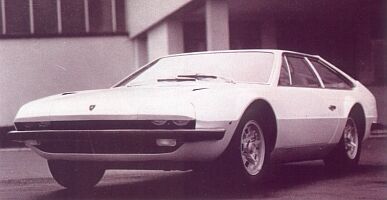 The
replacement for the Islero as
the 2+2 model in the Lamborghini range, the Jarama was introduced at the Geneva Motorshow
of 1970. The front-engine rear-wheel-drive chassis was based on that of the Espada, although much shorter,
whilst the mechanical parts were almost unchanged from that same car. The
design was again by Bertone, a very low and wide two door coupé, instantly recogniseable from the partially covered headlights (the coverings were
electrically operated) and two black NACA ducts in the bonnet.
The
replacement for the Islero as
the 2+2 model in the Lamborghini range, the Jarama was introduced at the Geneva Motorshow
of 1970. The front-engine rear-wheel-drive chassis was based on that of the Espada, although much shorter,
whilst the mechanical parts were almost unchanged from that same car. The
design was again by Bertone, a very low and wide two door coupé, instantly recogniseable from the partially covered headlights (the coverings were
electrically operated) and two black NACA ducts in the bonnet.
Technical Details
| Engine | 3929cc (82x62mm) 60deg V12 with 320bhp @ 7,500rpm (later 345bhp @ 7,800rpm) |
| Suspension | front : McPherson struts with coil spring/damper units and lower transverse arms plus anti-roll bar
rear : McPherson struts with coil spring/damper units and lower transverse arms plus anti-roll bar wheelbase : 2380mm track (front/rear) : 1490mm/1490mm |
| Brakes | ventilated discs all round with servo assistance
mechanical handbrake operating on the rear wheels |
| Transmission | 5 speed manual |
| Steering | worm and screw (ZF) |
| Kerb weight | 1540kg |
See our picture gallery index for images from museums, motorshows and events.
Copyright © 2000 to 2008 CarsfromItaly.com
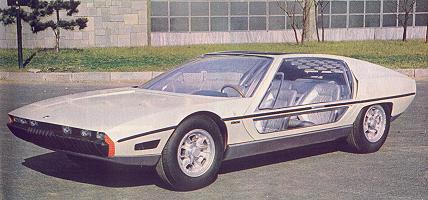 Return to the main Lamborghini page, use the buttons at the top to navigate
further, or LM002
Return to the main Lamborghini page, use the buttons at the top to navigate
further, or LM002